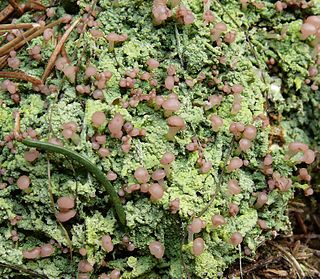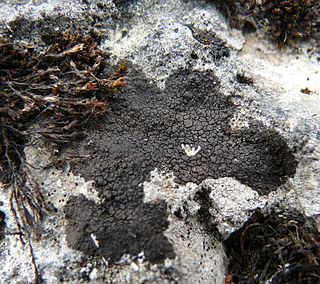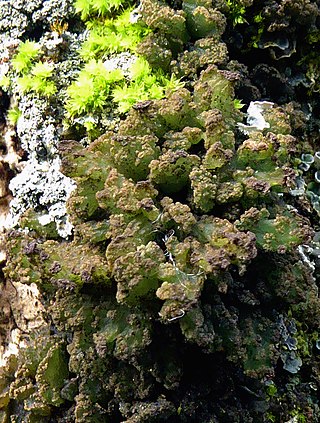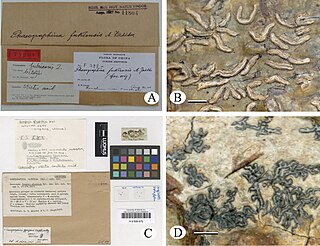
The Arthoniales is the second largest order of mainly crustose lichens, but fruticose lichens are present as well. The order contains around 1500 species, while the largest order with lichenized fungi, the Lecanorales, contains more than 14000 species.

Lichinales is the sole order of ascomycete fungi in the class Lichinomycetes. It contains three families: Gloeoheppiaceae, Lichinaceae, and Peltulaceae. Most species are lichenized. Lichinales was proposed in 1986 by German lichenologists Aino Henssen and Burkhard Büdel. The class Lichinomycetes was created by Valérie Reeb, François Lutzoni and Claude Roux in 2004.

The Pertusariales are an order of fungi in the class Lecanoromycetes, comprising 8 families, 31 genera, and over 600 species, many of which form lichens. This diverse group is characterized by complex taxonomic history and ongoing phylogenetic revisions. Originally proposed by Maurice Choisy in 1949 and later formally published by the lichenologists David L. Hawksworth and Ove Eriksson in 1986, Pertusariales has undergone significant reclassification due to molecular phylogenetics studies. The order includes well-known genera such as Pertusaria and Ochrolechia, as well as families like Megasporaceae and Icmadophilaceae.

The Ostropales are an order of fungi in the class Lecanoromycetes. The order was circumscribed by Swedish botanist John Axel Nannfeldt in 1932. The order contains 4 families and 46 genera, including 6 genera of uncertain familial placement.

The Baeomycetales are an order of mostly lichen-forming fungi in the subclass Ostropomycetidae, in the class Lecanoromycetes. It contains 8 families, 33 genera and about 170 species. As a result of molecular phylogenetics research published in the late 2010s, several orders were folded into the Baeomycetales, resulting in a substantial increase in the number of taxa.

The Graphidaceae are a family of lichen-forming fungi in the order Graphidales. The family contains nearly a hundred genera and more than 2000 species. Although the family has a cosmopolitan distribution, most Graphidaceae species occur in tropical regions, and typically grow on bark.

The Gyalectaceae are a family of fungi in the order Gyalectales.

Porinaceae is a family of lichen-forming fungi in the order Gyalectales. While Trichotheliaceae was proposed as an alternative, Porinaceae is the widely accepted name following ongoing nomenclatural discussions. Most members of this family typically have a crust-like appearance and grow on a variety of surfaces, including tree bark, leaves, and rocks. Porinaceae is known for its diverse morphology, ranging from simple crust-like forms to more complex structures with distinct lobes or fan-shaped scales. Porinaceae species generate small, typically flask-shaped reproductive structures, which house spores essential for reproduction. It includes nine recognised genera and more than 365 species, with significant diversity in tropical and subtropical regions.

Verrucariaceae is a family of lichens and a few non-lichenised fungi in the order Verrucariales. The lichens have a wide variety of thallus forms, from crustose (crust-like) to foliose (bushy) and squamulose (scaly). Most of them grow on land, some in freshwater and a few in the sea. Many are free-living but there are some species that are parasites on other lichens, while one marine species always lives together with a leafy green alga.
Sagiolechia is a genus of lichen-forming fungi in the family Sagiolechiaceae. The genus was circumscribed by lichenologist Abramo Bartolommeo Massalongo in 1854, who assigned Sagiolechia protuberans as the type species. The family Sagiolechiaceae was proposed in 2010 to contain Sagiolechia as the type genus, and genus Rhexophiale; molecular phylogenetic analysis showed that these two genera formed a distinct clade in the Ostropales.

The Arctomiaceae are a family of lichenized fungi in the Ascomycota, class Baeomycetales. The family was named by Theodor Magnus Fries in 1861, with Arctomia as the type genus. Species in this family are found in arctic and subarctic habitats, usually associated with bryophytes.

Trapeliaceae is a family of lichens in the order Baeomycetales. The family contains 12 genera and about 125 species.

Schaereria is a genus of lichen-forming fungi. It is the sole genus in the family Schaereriaceae, which itself is the only family in the Schaereriales, an order in the subclass Ostropomycetidae of the class Lecanoromycetes. Most Schaereria species are crustose lichens that live on rocks. Schaereria was first proposed by Gustav Wilhelm Körber in 1855 and was later taken up by other lichenologists despite periods of disuse.

The Rhizocarpales are an order of lichen-forming fungi in the subclass Lecanoromycetidae of the class Lecanoromycetes. It has two families, Rhizocarpaceae and Sporastatiaceae, which contain mostly crustose lichens.
Sagiolechiaceae is a small family of lichen-forming fungi in the order Ostropales. It contains two genera, Rhexophiale, and Sagiolechia, the type genus. The family was circumscribed in 2010 by lichenologists Elisabeth Baloch, Robert Lücking, H. Thorsten Lumbsch, and Mats Wedin. Molecular phylogenetic analysis showed that the two genera formed a distinct clade in Ostropales. Four species were included in the original circumscription of the family.

Thelenellaceae is a family of lichen-forming fungi. It is the sole family in the monotypic order Thelenellales, and contains three genera and about 50 species.

The Collematineae are an suborder of rust fungi in the order of Peltigerales in the class Lecanoromycetes.

Graphidales is an order of lichen-forming fungi in the class Lecanoromycetes. It contains 6 families, about 81 genera and about 2,228 species. Family Graphidaceae are the largest crustose family within Graphidales order comprising more than 2000 species, which are widely distributed in tropical and subtropical regions of the world.

Saxiloba is a genus of lichen-forming fungi in the family Porinaceae. It comprises three species of saxicolous (rock-dwelling) placodioid lichens, known from disjunct locations in the Caribbean, Hawaii, and Brazil. The genus was circumscribed in 2020 to accommodate species with a distinctive placodioid thallus featuring unique surface patterns and internal crystal structures. Saxiloba lichens are characterised by their flattened, leaf-like thalli with marginal lobes, growing tightly appressed to rock surfaces. They have a complex internal structure, including large crystal clusters embedded within the photobiont layer, which may be an adaptation for light management in their typically shaded habitats.


















